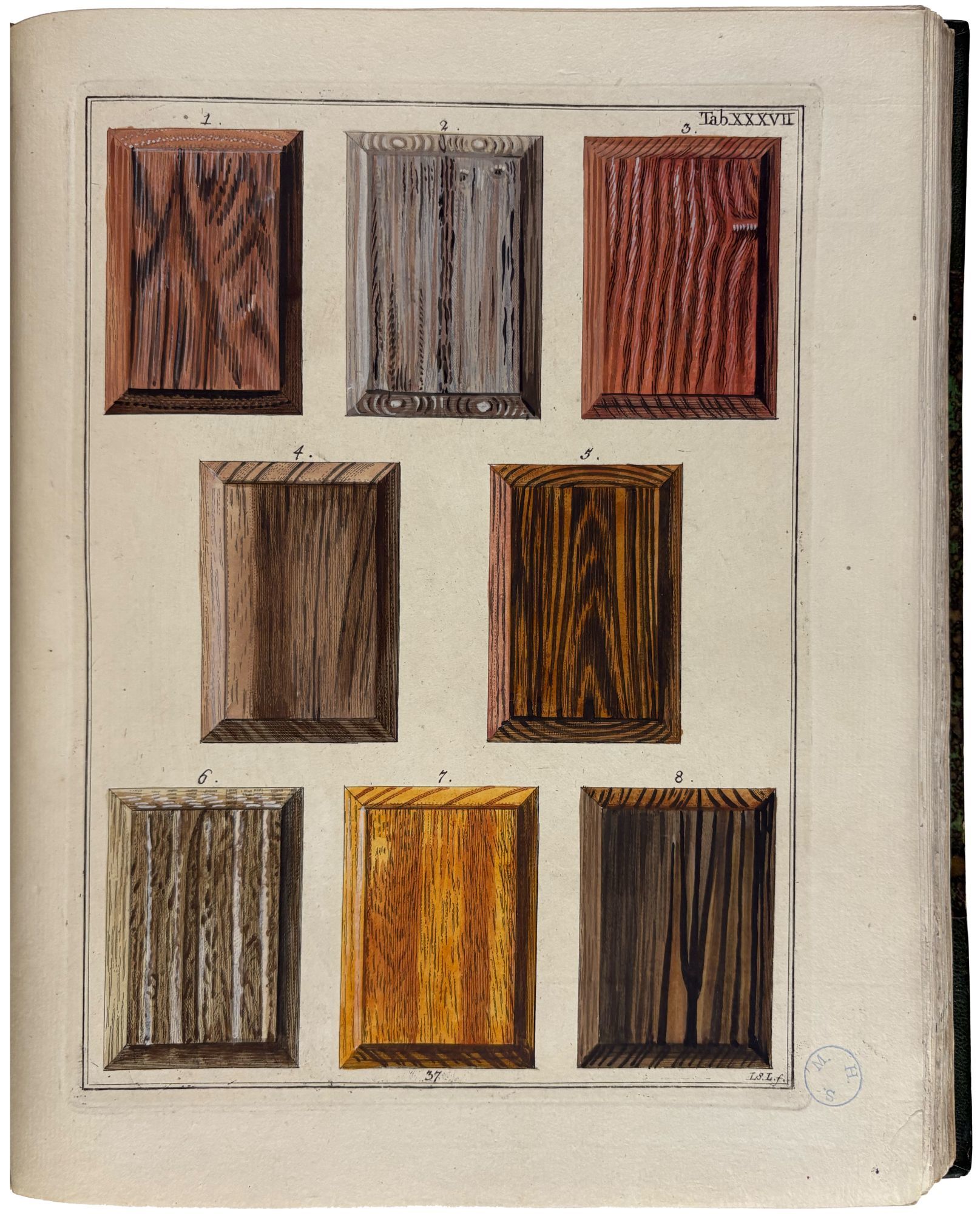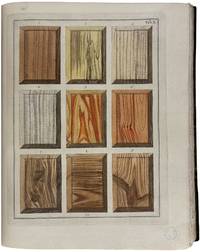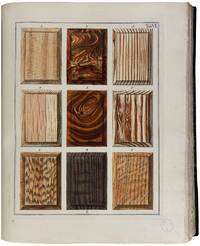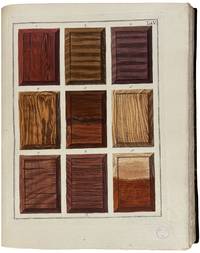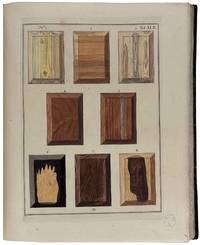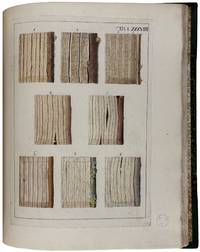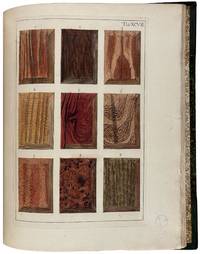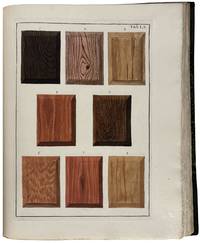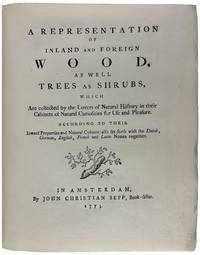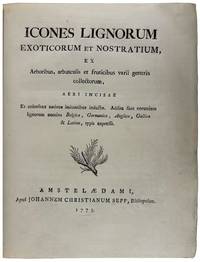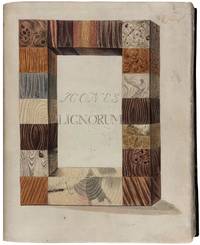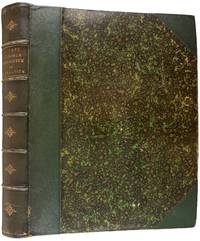Houtkunde, Behelzende de Afbeeldingen van Meest Alle Bekende, in-en Uitlandsche Houten. Die tot den Huis-en Scheepsbouw, tot Schrynwerk, Werktuigen en Gereedschappen, tot Verwstoffen en in de Geneeskunde, Worden Gebruikt: Op zulk eene manier, als die door de Liefhebbers der Natuurlyke Historie, tot Vermaak en Nuttigheid, worden verzameld en bewaard; Met Aanwyzing van Derzelver, Afkomst, Hoedanigheden en Gebruik: Voorgesteld in de Natuurlyke Tekening en Koleuren, Volgens de Hollandsche, Hoogduitsche, Engelsche, Fransche en Latynsche Benaamingen, En met uitvoerige Bladwyzers verykt. [A Representation of Inland and Foreign Wood, as well as Trees and Shrubs]
- SIGNED 4to
- Amsterdam: J. C. Sepp, 1795
Amsterdam: J. C. Sepp, 1795. 4to. (11 5/8 x 9 1/2 inches). General title; advertisement leaves; 5 additional title-pages in Dutch, German, English, French, and Latin; foreword; indexes/tables in 5 languages, with folding errata leaf; sectional title for the Supplement. (Signing and pagination in the English table skip two leaves, as issued, but the text of the table is complete). Illustrated with 106 hand-coloured plates (100 hand-coloured plates and 6 hand-coloured supplement plates). Discreet library stamps in the bottom right margins of plates. 19th-century half olive morocco, marbled boards, spine with raised bands forming six compartments, lettered gilt in the second compartment, others with gilt centerpieces, top edge gilt
Provenance: Massachusetts Horticultural Society (bookplate dated 1892)
The most beautiful book on wood ever published. This copy with the rare six supplementary plates.
Houttuyn and Sepp's book has become an essential guide to the identification of woods by their grains and colours, containing over 600 cross-sections of European and exotic woods. Jan Christaan Sepp based this work on Michael Seligmann's 'Abbildung in- und ausländischer Hölzer' (Nuremberg, 1773-78). He added plates showing timbers from the West Indies, drawn from the Cabinet of Reverend Hazeu at Rotterdam. Martinus Houttuyn was enlisted to describe specimens of timber from his own collection and prepare notes and indexes in five languages, which allows the reader to compare species by grain and colour. The colouring was carried out with exceptional care so that the plates present the 'living colours' of the specimens. The present work belongs to a period when natural history, craftsmanship, and commerce were closely intertwined in the Low Countries. Amsterdam in the late eighteenth century was both a hub of botanical illustration and a centre of the global timber trade. Specimens from the West and East Indies, Surinam, and Ceylon arrived through Dutch mercantile routes and were prized for cabinet work, shipbuilding, and scientific study. Houttuyn's project reflects this intersection of art, science, and trade: a compendium intended not only for the scholar and naturalist, but also for the artisan, merchant, and collector. The precision with which Sepp's engravers captured the texture and colour of each polished section mirrors the broader Dutch fascination with materials and taxonomy that animated the work of Linnaeus and his circle. Within this context, the book stands as both a document of Enlightenment classification and an object of aesthetic pleasure, uniting scientific observation with the artistic discipline.
Nissen BBI, 939, Landwehr 84; Pritzel 4291; Raphael, An Oak Spring Sylva 6; Bradley I, p.124; BM (NH) IV, p.1902; Brunet V, 291; Stafleu and Cowen 3082.
Provenance: Massachusetts Horticultural Society (bookplate dated 1892)
The most beautiful book on wood ever published. This copy with the rare six supplementary plates.
Houttuyn and Sepp's book has become an essential guide to the identification of woods by their grains and colours, containing over 600 cross-sections of European and exotic woods. Jan Christaan Sepp based this work on Michael Seligmann's 'Abbildung in- und ausländischer Hölzer' (Nuremberg, 1773-78). He added plates showing timbers from the West Indies, drawn from the Cabinet of Reverend Hazeu at Rotterdam. Martinus Houttuyn was enlisted to describe specimens of timber from his own collection and prepare notes and indexes in five languages, which allows the reader to compare species by grain and colour. The colouring was carried out with exceptional care so that the plates present the 'living colours' of the specimens. The present work belongs to a period when natural history, craftsmanship, and commerce were closely intertwined in the Low Countries. Amsterdam in the late eighteenth century was both a hub of botanical illustration and a centre of the global timber trade. Specimens from the West and East Indies, Surinam, and Ceylon arrived through Dutch mercantile routes and were prized for cabinet work, shipbuilding, and scientific study. Houttuyn's project reflects this intersection of art, science, and trade: a compendium intended not only for the scholar and naturalist, but also for the artisan, merchant, and collector. The precision with which Sepp's engravers captured the texture and colour of each polished section mirrors the broader Dutch fascination with materials and taxonomy that animated the work of Linnaeus and his circle. Within this context, the book stands as both a document of Enlightenment classification and an object of aesthetic pleasure, uniting scientific observation with the artistic discipline.
Nissen BBI, 939, Landwehr 84; Pritzel 4291; Raphael, An Oak Spring Sylva 6; Bradley I, p.124; BM (NH) IV, p.1902; Brunet V, 291; Stafleu and Cowen 3082.


